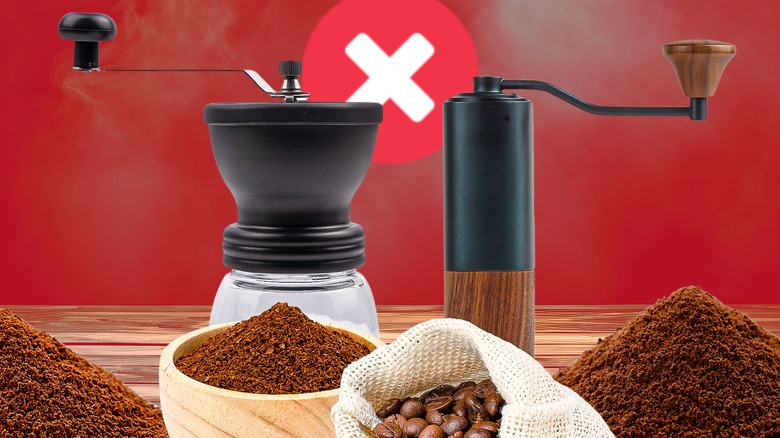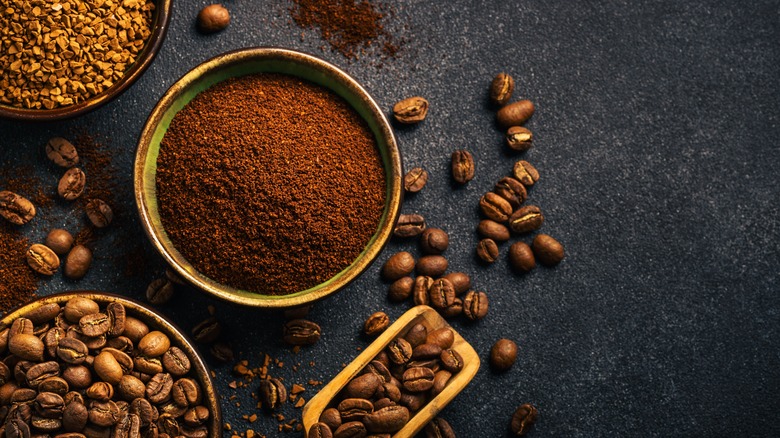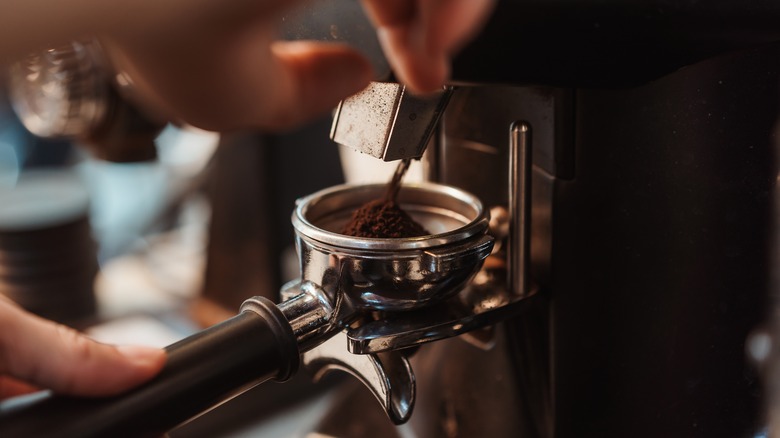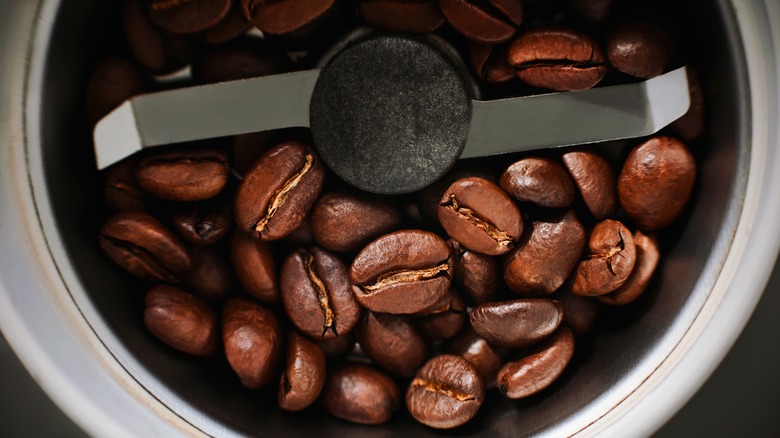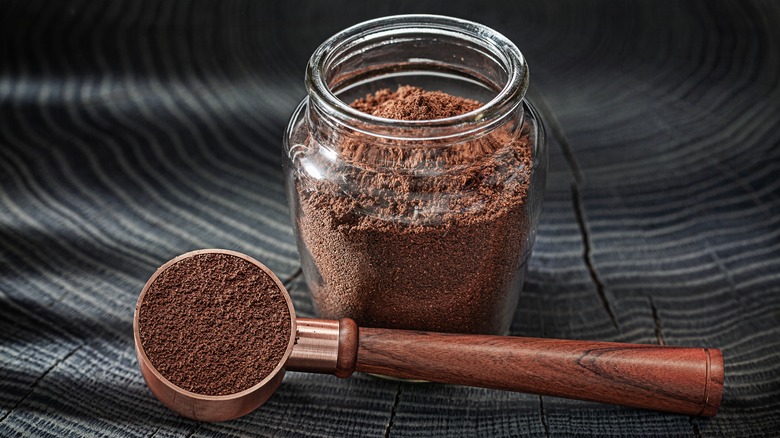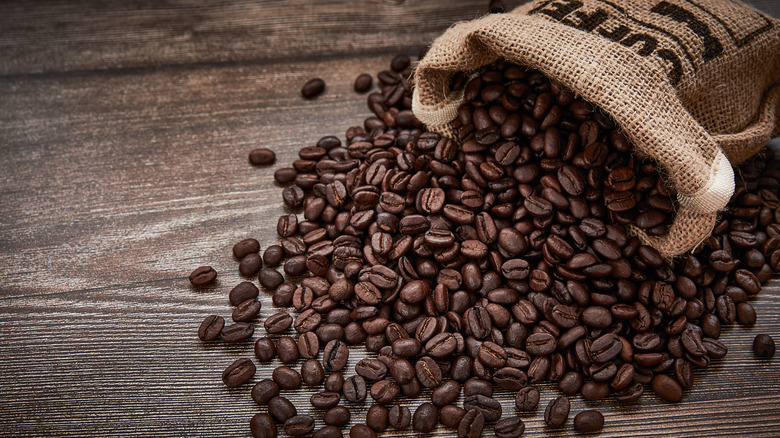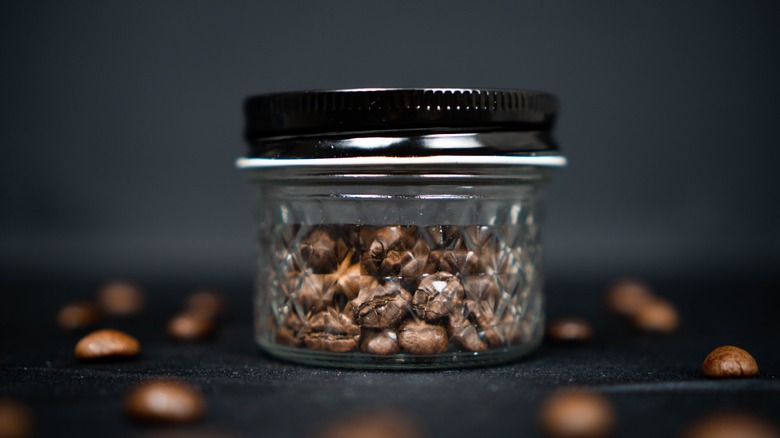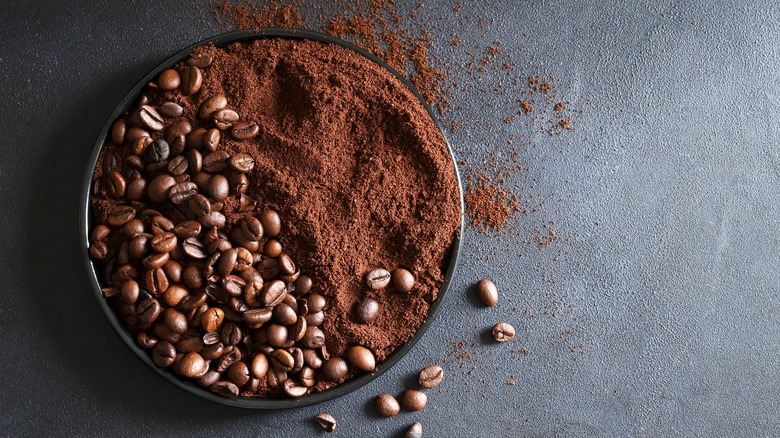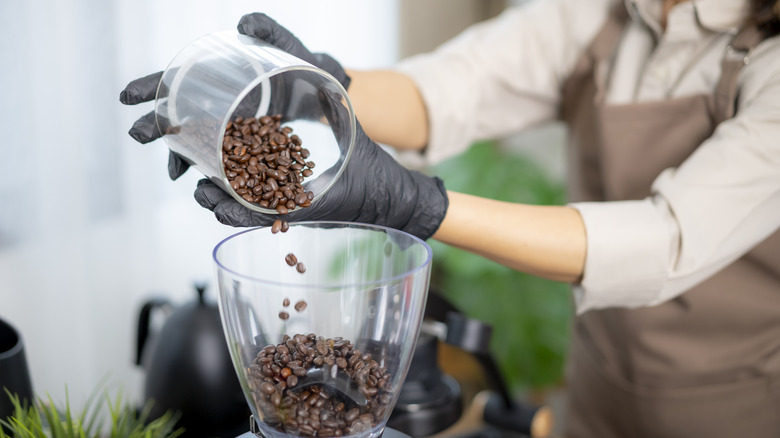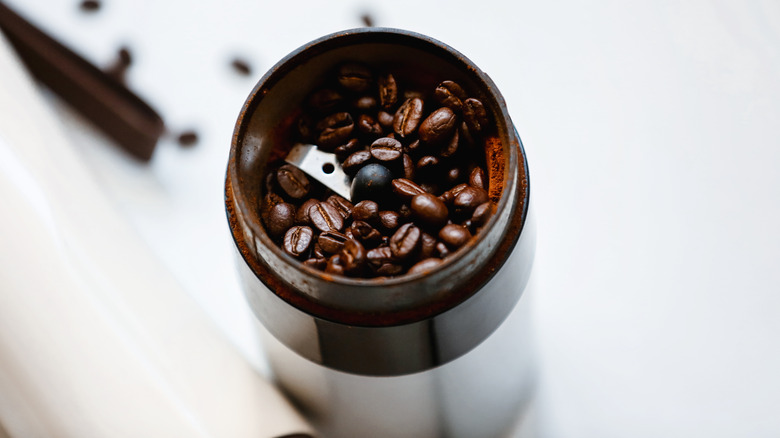10 Mistakes You Might Be Making With Your Coffee Grinder
Freshly ground coffee beans are the backbone of any good cup of java. The only way to achieve this is through the use of a coffee grinder.
Coffee grinders are vital tools that work by breaking down the beans into a coarse or fine powder, depending on your brewing method. There are many types of coffee grinders available, including manual grinders, electric grinders, and burr grinders. Each of these has its own set of strengths and weaknesses, which means choosing the right one for you depends on your favorite style of coffee.
While grinding coffee beans may not seem complicated, many common mistakes can significantly alter the quality and taste of your brew. Since grinding is an oft-overlooked step in the coffee-making process, Tasting Table has teamed up with former Starbucks barista and coffee expert Kayla Stavridis over at BaristaHQ to help set the record straight. Together, we've listed the common mistakes you might be making when using your coffee grinder, and what you can do to improve your cup of Joe.
Not matching your grind size to the brewing method
Different brewing methods require coffee grounds of different sizes. Not matching your grind size to your brewing method is a common mistake that can significantly impact your coffee.
Grind size denotes the coarseness or fineness of your coffee grounds, and is an important determination during the extraction process. Coffee extraction occurs when hot water is poured over the coffee grounds, which draws out caffeine, oils, acids, and other compounds from the grounds. How coarse or fine your grounds are determines how quickly water runs through them, and how much of these compounds are extracted. The finer the grounds, the slower the water passes through them, resulting in a greater extraction. In contrast, the coarser the grounds, the faster the water passes through them, and resulting in a lower amount of extraction.
Different brewing methods take advantage of this extraction process. For instance, French press coffee requires a coarser grind, whereas espresso requires a fine grind. As Kayla Stavridis points out, "using the wrong size can result in under-extracted or over-extracted coffee." Under-extraction can be caused by the grind size being too coarse, which typically creates a sour-tasting cup of coffee. Over-extraction can be caused by a grind size that is too fine, which creates an overly bitter-tasting cupful. Therefore, if you are looking to make good coffee, you want to avoid undergrinding or overgrinding your coffee beans by taking heed of what grind size is right for your brewing method.
Failing to dial in proper coffee grinder settings
Brewing coffee is as much of a science as it is an art. While you can rely on the science behind the brewing process to make a cup of coffee, elevating that cup of Joe requires an artistic approach of trial and error.
First and foremost, every type of coffee grinder is different. Essentially, the rate and amount of coffee beans processed in a grinder varies by machine, which means your grinder is very different from other grinders used by your friends or neighbors. Additionally, the coffee beans you use will also affect the grinding rate. Because of this, failing to take the time to dial in settings on your specific grinder is another common coffee-making mistake.
"Spend time adjusting your grinder settings to find the sweet spot. This might mean making several test brews," advises Kayla Stavridis. Start by changing one variable at a time to more easily determine what works and what doesn't. If your grinder is new, begin with the middle setting. Once you have a good baseline, slightly adjust the grind setting by one or two numbers while making your next few cups of coffee. Keep this process going until you find the right settings that produce your preferred cup of java. Once you have your grinder settings properly dialed in, you can start to experiment with different types of brews and coffee beans.
Using a blade grinder instead of a burr grinder
When it comes to grinding coffee beans at home, many experts urge against using blade grinders. These are coffee grinders that utilize two small blades to grind coffee beans at high velocities, similarly to standard kitchen blenders, to slice and chop your beans. While these grinders are typically cheaper and the first choice for most beginners, they are best avoided for several reasons.
Since blade grinders only utilize two blades to grind the beans, they often do the job inconsistently. Some coffee beans may hit the blades more often than others, creating an uneven batch of grounds. Because uneven grounds result in an uneven extraction of flavors, using this type of grinder can result in unpredictable coffee flavor. Additionally, since the two blades in the grinder turn at such a high velocity, they often create friction and heat that can burn your coffee beans, resulting in a more bitter taste.
Instead of buying a blade grinder, Kayla Stavridis recommends that you "invest in a burr grinder for consistent, precise grinds." A burr grinder, also known as a burr mill, is a type of grinder that utilizes two abrasive surfaces, called burrs, to crush coffee beans repeatedly into consistently sized particles. The beans are pulverized between the moving grinder wheel and the non-moving surface. There are two types of burr grinders — conical burr grinders and flat burr grinders — and both types produce consistent, even grounds perfect for brewing coffee.
Pre-grinding your coffee beans in advance
Picture this: you have an early-morning work shift, and you cannot function without caffeine, so you get your coffee maker ready the night before by pre-grinding your coffee beans. While this scenario may make your morning routine easier, it will actually result in a weaker and lower-quality cup of Joe. You shouldn't grind coffee beans too far in advance — this is a common mistake that can significantly affect the quality of your coffee.
Here's why. Basically, as soon as you grind your coffee beans, they begin to lose their aroma and flavor due to oxidation. Think of a coffee bean as a protective casing holding in the taste and smell profile within. To unlock those flavors and aromas, you need to grind up the bean — however, by grinding the bean into a coarser or finer powder, you are creating a larger surface area. Once that larger area is exposed to air, it begins to oxidize, or in other words, grow stale. Therefore, the earlier you pre-grind your coffee beans, the worse the cup of coffee produced by them.
"Grind coffee just before brewing," Kayla Stavridis advises. "The ideal time between grinding and brewing should be at most 30 minutes." This means that you have about a half hour after grinding the coffee beans to brew your java. This is also the reason why many coffee aficionados also advise against buying pre-ground coffee.
Using lower-quality coffee beans
A good cup of java starts with high-quality coffee beans. Using lower-quality beans is a common mistake, and one of the main culprits behind weak or terrible coffee. How can you choose the right coffee beans to use, and which are worthwhile? This may seem like a challenging task, but it isn't as hard as you may think. What it comes down to are several different characteristics to keep in mind.
There are two main varieties of coffee beans: arabica beans and robusta beans. Arabica beans have a more delicate flavor profile, whereas robusta beans are stronger and more bitter. Additionally, robusta beans are easier to grow, making them more cost-friendly than arabica beans. In most cases, high-quality coffee is made from 100% arabica, or a blend of both types of beans.
Coffee beans can also be single-origin or a blend. Single-origin coffee is the product of beans harvested from one specific region, such as Hawaiian Kona or Brazil Cerrado. These coffee beans develop the unique flavors of the region's soil and environment. In comparison, blends comprise beans sourced from multiple geographical locations, resulting in a mixture of different flavors. In most cases, high-quality coffee is sourced from a single region. Still, the choice comes down to personal preference. Just make sure the beans are fresh, correctly processed, and free from defects. "No grinding technique can hide low-quality beans," says Kayla Stavridis.
Using stale or older coffee beans
It isn't just the quality of the coffee beans that can affect your wake-up cup — using stale or older beans can alter the taste of your coffee as well. After coffee beans are roasted, they develop their flavors and aromas; however, this process also causes the carbon dioxide within the bean to seep out, as a slow decomposition process begins. Then the cell structure of the beans begins to decay as oxygen seeps in. All of this results in the coffee bean growing stale. From the time of roasting, you have about one to two weeks before the bean's compounds start to break down.
Since stale coffee results in less complex flavors, it is important to always use fresh beans when making a cup of java. You can ensure that your beans are fresh by checking the roasting date on the packaging. "Ideally, use coffee beans within a month of their roast date for maximum freshness and flavor," advises Kayla Stavridis.
You can also use a bag trick to check if your coffee beans are still fresh. This hack entails placing a half cup of beans into a bag, sealing it, and leaving it overnight. If the bag inflates, then the beans still contain carbon dioxide, which means they are fresh.
Using uneven coffee grounds
As mentioned, uneven coffee grounds make for an uneven extraction process, resulting in a lower-quality cup of coffee. Because of this, you need to avoid common mistakes that produce uneven grounds.
While blade grinders are notorious for yielding uneven coffee grounds, other types of grinders are also prone to creating uneven grounds due to clumping. Clumping is a term that refers to when coffee grounds stick together during the grinding process. This typically occurs due to excess amounts of oils in the beans, which mixes with the finely ground powder. It can also occur due to a buildup of static electricity produced by the grinding process, or because of an improperly maintained grinder.
Investing in a high-quality grinder, like a burr grinder, is the best way to get consistently sized coffee grounds — however, even these grinders are prone to clumping. To avoid uneven grounds in a burr grinder, "ensure your grinder is well-maintained and the burrs are sharp," says Kayla Stavridis. If you cannot invest in a high-quality grinder, use a simple hack to grind coffee beans evenly, which entails lifting and shaking the machine gently during the grinding process.
Grinding too many or too few coffee beans
Since coffee beans begin to lose their aroma and flavor as soon as you grind them, understanding how many beans you need to grind is vital. After all, if you add too many beans to your brew, your coffee may come out overly bitter. On the flip side, if you don't add enough beans, you'll end up with weak or bland coffee. How can you brew the perfect amount of coffee? Through measuring.
You can accurately measure your coffee by using a coffee scale, which is a device that measures the weight of coffee and water for the brewing procedure. While there are subtle differences, coffee scales are very similar to standard kitchen scales, so it isn't uncommon to use either type when measuring coffee. When it comes to actually measuring your coffee, Kayla Stavridis explains that "a good starting point is a ratio of 1:15 (coffee to water) for most brewing methods." What this means is that you will use 1 gram of coffee beans to 15 grams of water. Since a normal 8-ounce cup of coffee holds around 225 grams of water, you will likely need about 15 grams of ground coffee per cup.
It's also worth noting that contrary to popular belief, measuring coffee beans with a spoon is entirely inaccurate, because the beans are not uniformly sized or shaped and will not fit evenly in the spoon. The only way to accurately measure coffee is with a scale.
Not cleaning or maintaining your coffee grinder
As with any kitchen appliance, not cleaning or maintaining your coffee grinder can result in problems. This is especially true if you're trying to achieve a good cup of coffee.
When you grind coffee beans, the oils and particles from the beans get stuck to the grinder's interior. Over time, the oils become rancid, and the longer they accumulate, the more they leach into your coffee grounds. If your cup of coffee has an oily taste, then it's most likely due to leftover oil in your grinder. In addition, these oils can also result in clumping, which leads to uneven coffee grounds. For these reasons, it is essential to keep your grinder clean. As to how often you should clean your grinder, Kayla Stavridis recommends "at least once a month."
Coffee grinders are a little tricky to clean because they have an electric motor that can be damaged if cleaned with soap and water. Therefore, to clean your grinder, you need to start by taking it apart. Most at-home grinders are easy to disassemble; however, refer to your owner's manual if you encounter any trouble. After disassembling, clean each component separately. If you own a burr grinder, never clean the burrs with soap and water, since they are usually made from high-carbon steel and are prone to rusting if wet. Instead, use grinder-cleaning tablets and brush them off. Grinder-cleaning tablets are specially designed to remove coffee residue and oils from burr coffee grinders.
Letting static electricity build up in your coffee grinder
All coffee grinders create friction when grinding beans. Friction occurs when surfaces rub against each other, resulting in static electricity that is caused by an imbalance of positive and negative charges in a material, occurring when electrons move from one surface to another. As the coffee beans in your grinder swirl around the burrs or blades, they create static electricity.
"Static [electricity] in your grinder can cause uneven extraction," Kayla Stavridis notes. This can produce inconsistent cups of coffee, or can lead to clumping. While static electricity buildup in coffee grinders cannot be avoided entirely, you can lessen it through several methods.
One way to help lower the amount of static electricity in your grinder is through the Ross droplet technique. Basically, this entails wetting the back of a spoon and stirring it around in your coffee beans before grinding them. You will want to use only a tiny amount of water, since using too much can damage the grinder. Another method to lessen the amount of static is to simply be patient. After grinding your coffee, wait a few minutes before removing the container and dumping out the grounds. Lastly, most coffee grinders utilize plastic containers for the grounds, and plastic serves as an insulator of electricity, causing static electricity to build up. If you swap out your plastic container for a metal container, which conducts electricity away from the grounds, you can effectively reduce the amount of static electricity.
